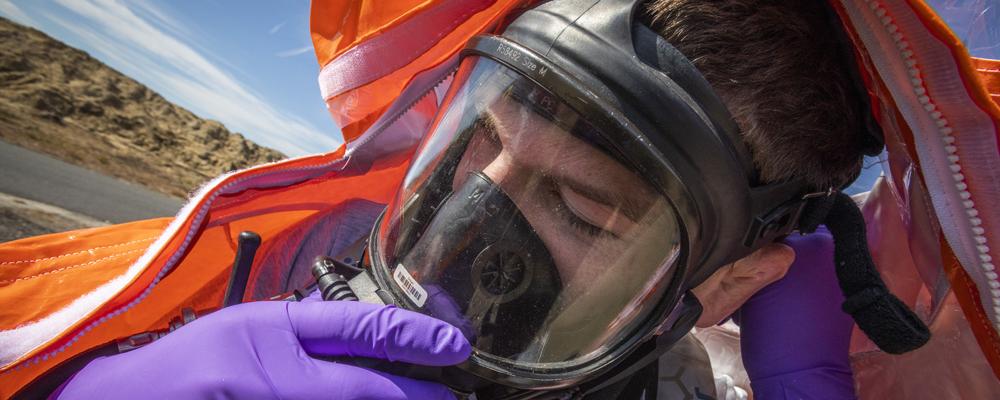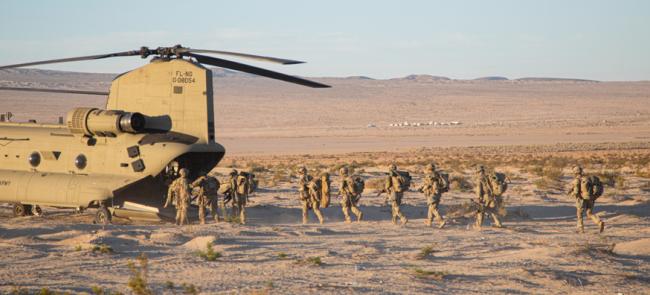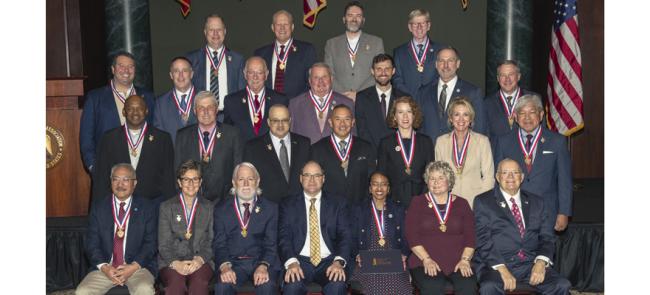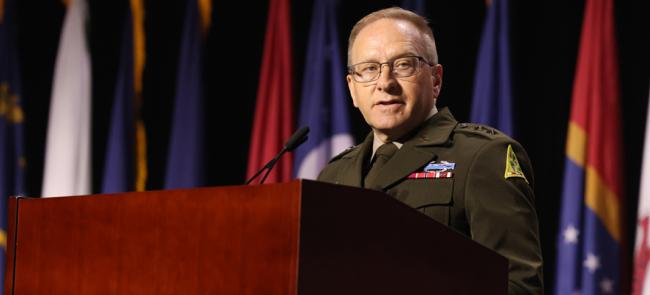
Masks Required
Two years ago when the COVID-19 pandemic struck, tens of thousands of National Guard soldiers and airmen donned protective equipment and helped their communities.
For members of most Guard Weapons of Mass Destruction-Civil Support Teams, like New Jersey’s 21st WMD, it was largely business as usual.
The 22 full-time-member team’s normal mission is to assist communities with potentially harmful situations, a task that requires working with civil authorities, including health officials and practitioners. And it’s often in protective equipment.
But nothing is routine about a pandemic.
“The extent to which this has affected this country, and for as long as it has, I think kind of surprised everybody,” said Lt. Col. Clifford Giampietro, the unit’s commander. “We were just grateful to help in the way that we could.”
The 21st CST is one of 57 total CSTs in each state, Guam, Puerto Rico, the U.S. Virgin Islands and the District of Columbia. California, Florida and New York have two teams.
They have taken on diverse missions over the years, including responses to ricin attacks, volcanic eruptions, lost radiological sources, contaminations from discarded chemical weapons and drug-related investigations.
They also advise local authorities on how to protect large gatherings that might be a soft target for terrorists. Sometimes the job requires remaining at the site for the event just in case. The 21st CST has done such work at the U.S. Open and the Boston Marathon.
“Most of those missions are us just being on stand-by in a venue where someone needs extra protection in the event something happens,” Giampietro says.
By the time the World Health Organization declared COVID-19 an official pandemic in March 2020, numerous CSTs were helping to conduct drive-through testing for thousands of civilians alongside their local health care workers. CSTs also advised state and local officials on personal protective equipment, decontamination measures and the latest in testing capabilities.
Giampietro says the unit felt sufficiently prepared to respond to the pandemic.
“I feel we were well-trained to handle this,” he said. “It falls into a similar category as biological warfare for us, so the overlap was sufficient that we were able to contribute in a meaningful way.”
In dense population centers like northern and southern California, CSTs worked with state public health labs to shore up testing shortfalls. In New York City, the 24th CST tested thousands of civilians and first responders from the Jacob K. Javits Convention Center at the behest of the governor.
The 21st CST assisted the 24th CST throughout the pandemic.
“We sent a few guys up there, based on their request and their needs,” Giampietro said. “We have the personnel to support, and so we did.”
Some states directed teams to drive their mobile labs to underserved, rural population areas and nursing homes. Teams also lent trained personnel to assist public health laboratories and hospitals with enormous testing burdens.
The 21st CST assisted with N95 mask fit testing for long-term care facilities and veterans’ homes, along with helping these facilities with how they test their patients and staff.
Sgt. Quran Williams, a member of the unit’s survey team, helped with the unit’s mask-fit testing efforts at the various facilities the unit visited throughout the pandemic.
“It helped make the employees feel safe,” Williams says.
Williams said there were two methods to determine if a mask was working. One method was using a respirator machine to see if the mask was functioning correctly. The other method, which the unit used regularly, was introducing a gas sample into the air that could be smelled or tasted. People would then put on the mask and a stronger sample would be introduced to see if the mask worked.
“It was more efficient with fit testing, especially at a rapid pace,” he says. “We’re testing thousands of soldiers and that test only takes 10 to 15 minutes, while the [machine test] might take 30 to 45 minutes for each person.”
Capt. Brandon Botley, the unit’s operations officer, said the only challenge the unit had to deal with early in their mission was trying to get masks.
“We couldn’t walk around in our military masks and have freaking people out,” he said. “We had to deal with all the other supply-chain issues that other entities faced in the beginning.”
Botley said that the unit provided liaison support for the managers of the long-term care facilities “to get the lay of the land” before Guardsmen came in to assist the understaffed facilities. The unit assisted facilities with setting up decontamination rooms, how to separate contaminated patients and which PPEs to use.
“We basically had to get their procedures correct, so we can ensure that when these soldier and airmen came in that they were safe,” Botley said. “Our primary concern was the safety of the airmen and the soldiers.”
Botley said the unit also helped train Guardsmen who would be assigned to these facilities.
“They don’t come from the background that we do,” he said. “Their level of knowledge was far lower than the people working at the facilities. In turn, we had to teach them from the ground up to keep themselves safe.”
The 21st CST provided mask fitting testing and training assistance to 1,650 military personnel between March 2020 and February 2022, according to unit data.
“For the people who weren’t familiar with the stuff they were using and going into a foreign environment, we acted as a buffer for the organizations and giving them a sense of comfort with the equipment they were using,” said Maj. Rene Roa, the unit’s deputy commander.
Between March 2020 and February 2022, the unit made 50 total site visits, including drive-thru testing sites, long-term care facilities, veterans’ homes and mortuary affairs locations. Botley says the unit would visit these sites multiple times.
“We typically broke into three to five-man teams [to visit these facilities],” he said. “Sometimes, each team would visit multiple locations per day, every day, for months. They would go back to provide training, provide follow-up visits to make sure the facilities were in turn following the guidance we gave them and to talk to the personnel there to ensure they were staying safe.”
The 21st CST worked with the New Jersey Guard, New Jersey State Police and New Jersey state leadership in improving the process of body disposal, including how the bodies should be handled and the routes the teams should take when disposing of the bodies. Botley said most of the casualties from COVID-19 in New Jersey came from long-term care facilities.
“They asked us to go in and look at the process and see where we can improve it,” he says.
Giampietro spoke highly of the unit’s eagerness to help where they were needed throughout the pandemic.
According to NGB, the CSTs have conducted a total of 795 COVID-19 missions to date. 53 of the 57 CST teams have supported COVID missions since March 2020, with more than 120,000 diagnostic tests performed.
The 21st CST is currently still involved with liaison work in the state of New Jersey. According to the NGB, two CSTs — the 95th CST in California and the 24th CST — are still conducting COVID missions. All other CSTs are conducting their normal missions.
The author can be reached at [email protected].
AT A GLANCE
Civil Support Teams
MISSION: Rapidly identify chemical, biological, radiological and nuclear substances, assess consequences; advise incident commanders on response measures and assist requests for follow on military support
PERSONNEL: 22 (all full time) divided among six sections: command, operations, communications, administration/logistics, medical/ analytical and survey
DEPLOYMENT SPEED: Advance team deploys within 90 minutes of notification; main body within three hours
NUMBER: 57 (at least one in every state, Guam, Puerto Rico, U.S. Virgin Islands and the District of Columbia, with two in California, Florida and New York)
FIRST FIELDED: 1999 (operational in 2001)
Source: National Guard Bureau



